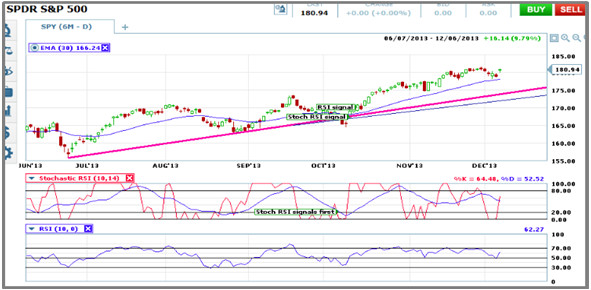When Two Worlds Collide. Stochastic RSI for Binary Options
Full Review of the Stochastic RSI for Binary Options Trading
Stochastic and RSI are both well respected technical indicators. Each measures the markets in a unique way. This indicator is a fusion of the two, in essence it’s an indicator of an indicator that works well for binary options.
This is an indicator introduced in the early 90’s by Tuschar Chande and Stanley Kroll in an issue of Stocks and Commodities magazine. It is a combination of two well know indicators and gives a deeper insight into the RSI. In effect, the indicator is a stochastic reading of RSI, providing an oscillator that measures the current value of RSI versus the highs and lows over the past X period. The formula is mildly complex but displays as a typical oscillator. The biggest difference with this indicator to understand is that while stochastic and RSI are both derived from asset prices, the stochastic RSI is derived from RSI values.
How Does It Work
As I said this indicator is basically a stochastic model based on RSI values rather than prices. Other than that it functions just as any other oscillator would. It moves in range over and under 0 as the assets prices move up and down. The indicator can be used to get the same signals as other oscillators and may even be better than RSI alone. Signals include Overbought, oversold, zero line crossover and extreme range crossovers. It can also be used to identify areas of support, resistance and can even predict reversal with divergences.

The most basic signal is overbought/oversold crossovers. If your chart package does not provide lines marking extreme overbought and oversold levels you can draw you own. Simply look back over the past 12 months and identify the peaks, then draw a line that allows the tips of the peaks to cross above and below. For a signal watch for the indicator to enter either the overbought or oversold range. When prices begin to reverse and the indicator crosses out of the OB/OS region enter a position. A bullish signal is when the indicator moves above the oversold line. A bearish signal is when the indicator moves below the overbought line. An extension of the OB/OS signal is the zero line crossover. When the indicator moves from one extreme to the other you can take a trend following signal once it crosses the zero line.
Why This Indicator Might Suck
This indicator might suck for the reason that all indicators might suck. No indicators is full proof, they will all give you a false signal from time to time. The market is always changing and technical analysis is not an exact science. It might also suck if you use it by yourself. You should never rely on just one indicator for a signal.
Why This Indicator Doesn’t Suck
This indicator does not suck. It is a reliable oscillator built off of two different indicators with a known track record. The RSI is a good indication of market strength, stochastic is a great indicator of market direction. Together the provide a great indication of the direction of the markets strength. Not only that, adding the stochastic to the RSI helps to provide a clearer signal than the standard RSI. I have never really liked the RSI because it just does not present as one that I personally can see clear signals in. The stochastic RSI provides a much clearer signal and one that is easier to use.
My Last Words On Stochastic RSI
I like this indicator. Stochastic is one of my favorite indicators because of how it measures market movement. Applying it to RSI seems like a natural progression. The indicator analyzes the strength of the market, and the direction of that strength over time in a way that provides clear and recognizable signals. The RSI does not cross into overbought and oversold areas of the chart as quickly as the S- RSI which is why it provides so much of a better signal. The RSI itself relies on trend following signals and lags the signal provided by an overbought reading in the S-RSI.
Further Reading:
- Check out Relative Strength Indicator Full Review
- Learn more about stochastic crossovers for binary options